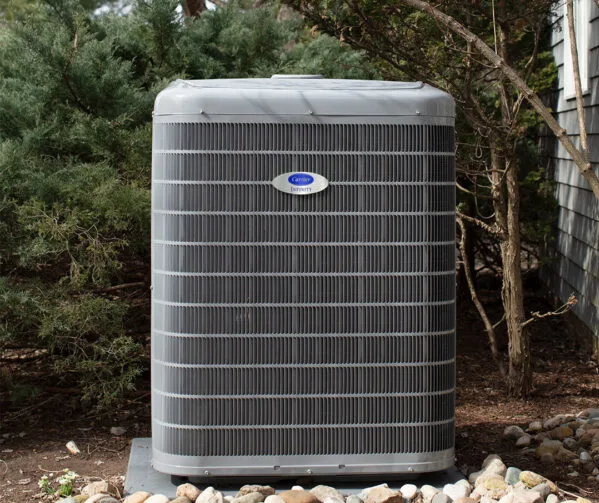Choosing an HVAC system for a home or business is a huge investment and an essential part of a comfortable home or successful business. With so many different types of systems, brands and models to choose from, the process can feel daunting. When educating oneself about HVAC, it’s important to break it down. So, today, let’s start with heat pumps.
Heat pumps are special for a number of reasons, but perhaps what makes them initially stand out from other HVAC systems is that they can be a double-purpose system. Because heat pumps provide both heating and cooling, it can provide relief to homeowners who do not want to worry about maintaining two systems.

Traditional systems rely on fossil fuels or electricity to produce hot or cool air. The energy put in is approximately equal to that which is expelled into the building as hot or cool air. However, it’s important to note that energy is frequently lost throughout this process (often through ductwork), depending on the system. Heat pumps run on electricity, but what they do with this energy differs from traditional HVAC systems. Heat pumps use electricity to absorb heat from the air or the ground (if it’s a geothermal heat pump). With the same amount of energy as a traditional system, a heat pump can move three to four times more heat and redistribute it into a new location. Not all heat pumps are designed to heat and cool, but those with this feature work inversely to the heating cycle and can move the heat from indoors to the outdoors, depending on the thermostat setting.
Gathering heat isn’t a new concept; in fact, heat pump technology was invented in 1856. Since then, the advancement in technology has made heat pumps more versatile in varying climates and many homeowners find this energy-efficient choice provides year-round comfort while saving on energy bills.

Before we can fully get started, we have to understand refrigerant. Refrigerant has extremely low boiling and freezing points. Because it has such a low boiling point (the most common one in use, R-410A, has a boiling point of -61° Fahrenheit), this allows the refrigerant to absorb heat with ease. As heat pump science advances, refrigerants have lower and lower boiling points, increasing their ability to absorb heat with the same efficiency in the coldest environments. On that topic, it’s a common misconception that heat pumps can’t work in very cold climates, but this isn’t true. In cooler climates, such as Massachusetts, an electric heat strip can be added to the indoor fan coil for additional capabilities for your home or commercial building.
Now, onto the interesting part. The refrigerant goes through a process within the heat pump, where it’s manipulated to heat or cool. We call this the refrigeration cycle.
Here’s how it works:
Evaporation:
When cooling, the process begins inside; when heating, the process begins outside. Either way, the first step of the refrigeration cycle is evaporation. In regards to heating your home, when the thermostat has been adjusted, electricity kicks on the heat pump, and the refrigerant is sent to absorb the heat from the outdoor air. Once the refrigerant has absorbed the heat, it will pass through the evaporator coil and transform from a liquid into a gas.

Compression:
The refrigerant is now in a gaseous form and can be compressed. When compressed into a smaller volume, the boiling temperature and pressure increases. When heating, the boiling temperature needs to reach that of the desired indoor temperature.
Condensation:
Once the gas has been pressurized, it can travel to the condenser coil. Here, the heat will be exchanged, and the refrigerant will transform from a gas into a liquid. When this happens, the heat will either be dispersed into the building (when in heating mode) or outdoors (when in cooling mode) by a fan.

Expansion:
Once the heat from the refrigerant has been released, the refrigerant is still too warm and must be cooled down further. So, next, it passes through the expansion valve. The expansion valve reduces the pressure of the refrigerant, which will, in turn, reduce its temperature. Once the refrigerant has reached the correct temperature, it’s ready to turn around and repeat the process.
Heat pumps are astonishing technology and with it comes some incredible benefits!

Energy Efficiency ⎸ Lower Operating Costs ⎸ Small Carbon Footprint
Offering three to four times more heat with the same amount of energy as other electric systems reduces energy bills significantly and removes the need to purchase gas or oil. Because heat pumps don’t directly burn fossil fuels, it reduces air pollution and greenhouse gas emissions to such an extent that some states offer rebates to those who opt for these eco-friendly systems. If you’re located in Massachusetts, learn more about how you can take advantage of MassSave rebates here.
Low-Maintenance ⎸ Adaptable ⎸ Zone-able
Installation for most heat pumps is quick and relatively easy, and upkeep is less involved compared to other systems. Geothermal heat pumps are more complex, but the increased long-term energy bill savings can make the process worthwhile. Heat pumps are compatible with ducted and ductless buildings, so they’re an option for most homes or businesses. Many people also appreciate that heat pumps can be zoned, meaning you can simultaneously have different temperatures in different rooms/areas. Zoning helps save money on energy bills because it allows you to only heat or cool rooms or areas that are occupied.
Safety ⎸ Long-Lifespan ⎸ Quiet Operation
A heat pump will bring peace of mind. While, yes, they are quieter than many other systems, they’re also safer. Without relying on combustion, the concern of fire hazards is removed. And you can count on this technology to serve you for around 15 years if it’s well-maintained.
If your question isn’t answered here, contact the Pierce Refrigeration team and one of our experts will guide you in finding the right solution for you.
Need 24-7 emergency service? Looking for advice on improving your everyday air quality and comfort at home and work? Contact the friendly staff at Pierce Refrigeration at 800-696-1088 or info@piercerefrig.com.
One downside to a heat pump is the misconception that it can’t work effectively in very cold climates. However, advancements in technology have made heat pumps more versatile in varying climates. Additionally, heat pumps may require an electric heat strip in cooler climates to provide additional heating capabilities.
The latest advancements in heat pump technology focus on improving the efficiency and performance of heat pumps, particularly in extreme climates. One notable advancement is the use of refrigerants with lower boiling points, allowing heat pumps to absorb heat with the same efficiency even in the coldest environments.
One major problem with heat pumps is their sensitivity to extreme temperatures. In very cold climates, heat pumps may struggle to operate efficiently, leading to temporary increases in energy consumption. However, the addition of an electric heat strip can help mitigate this issue.
Heat pump technology operates by utilizing refrigerants to absorb heat from the air or the ground (in the case of geothermal heat pumps) and redistributing it to heat or cool a space. The refrigeration cycle involves four main stages: evaporation, compression, condensation, and expansion. During these stages, the refrigerant undergoes changes in pressure and temperature to extract heat from one location and release it in another, providing heating or cooling as needed.

